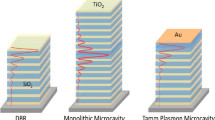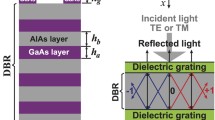Abstract
In this paper, new structures for hybrid plasmonic Bragg reflectors (HPBRs), based on sinusoidal and triangular gratings, are proposed. The proposed structures exhibit better characteristics compared to previously studied rectangular HPBRs. Among these two structures, the triangular HPBR exhibits a better performance in terms of passband ripples and bandwidth than that of the sinusoidal one. Therefore, the structure of a microcavity as a defect in the proposed triangular HPBR is studied and its Q factor is compared with other types of plasmonic microcavities. It is also demonstrated that an apodization technique can reduce the size of the triangular HPBR-based microcavity and improve its Q factor.







Similar content being viewed by others
References
Barnes WL, Dereux A, Ebbesen TW (2003) Surface plasmon subwavelength optics. Nature 424(6950):824–830
Avrutsky I, Soref R, Buchwald W (2010) Sub-wavelength plasmonic modes in a conductor-gap-dielectric system with a nanoscale gap. Opt Express 18(1):348–363. doi:10.1364/OE.18.000348
Flammer PD, Banks JM, Furtak TE, Durfee CG, Hollingsworth RE, Collins RT (2010) Hybrid plasmon/dielectric waveguide for integrated silicon-on-insulator optical elements. Opt Express 18(20):21013–21023
Oulton RF, Sorger VJ, Genov D, Pile D, Zhang X (2008) A hybrid plasmonic waveguide for subwavelength confinement and long-range propagation. Nat Photonics 2(8):496–500
Alam M, Caspers JN, Aitchison J, Mojahedi M (2013) Compact low loss and broadband hybrid plasmonic directional coupler. Opt Express 21(13):16029–16034
Bozhevolnyi SI, Volkov VS, Devaux E, Laluet J-Y, Ebbesen TW (2006) Channel plasmon subwavelength waveguide components including interferometers and ring resonators. Nature 440(7083):508–511
Sun X, Zhou L, Li X, Hong Z, Chen J (2011) Design and analysis of a phase modulator based on a metal-polymer-silicon hybrid plasmonic waveguide. Appl Opt 50(20):3428–3434
Zhao H, Guang XG, Huang J (2008) Novel optical directional coupler based on surface plasmon polaritons. Phys E Low Dimens Syst Nanostruct 40(10):3025–3029
Rattier M, Benisty H, Stanley RP, Carlin J-F, Houdre R, Oesterle U, Smith CJ, Weisbuch C, Krauss TF (2002) Toward ultrahigh-efficiency aluminum oxide microcavity light-emitting diodes: guided mode extraction by photonic crystals. IEEE J Sel Top Quantum Electron 8(2):238–247
Wierer J, Kellogg D, Holonyak N (1999) Tunnel contact junction native-oxide aperture and mirror vertical-cavity surface-emitting lasers and resonant-cavity light-emitting diodes. Appl Phys Lett 74(7):926–928
Hosseini A, Massoud Y (2007) Subwavelength plasmonic Bragg reflector structures for on-chip optoelectronic applications. In: Circuits and systems, 2007. ISCAS 2007. IEEE International Symposium on, IEEE, pp 2283–2286
Mu J-W, Huang W-P (2009) A low-loss surface plasmonic Bragg grating. J Lightwave Technol 27(4):436–439
Park J, Kim H, Lee B (2008) High order plasmonic Bragg reflection in the metal-insulator-metal waveguide Bragg grating. Opt Express 16(1):413–425
Xu P, Huang Q, Shi Y (2013) Silicon hybrid plasmonic Bragg grating reflectors and high Q-factor micro-cavities. Opt Commun 289:81–84
Xu C, Ting H, Chen R, Ping Y, Yang J, Jiang X (2013) Transmission characteristics of a plasmonic Bragg reflector based on a metal-embedded slot structure. J Opt 15(10):105005
Liu Y, Liu Y, Kim J (2010) Characteristics of plasmonic Bragg reflectors with insulator width modulated in sawtooth profiles. Opt Express 18(11):11589–11598
Sharma AK, Gupta BD (2006) Influence of temperature on the sensitivity and signal-to-noise ratio of a fiber-optic surface-plasmon resonance sensor. Appl Opt 45(1):151–161
Palik ED (1998) Handbook of optical constants of solids: index, vol 3. Access Online via Elsevier
Gedney SD (1996) An anisotropic perfectly matched layer-absorbing medium for the truncation of FDTD lattices. IEEE Trans Antennas Propag 44(12):1630–1639
Neutens P, Lagae L, Borghs G, Van Dorpe P (2012) Plasmon filters and resonators in metal-insulator-metal waveguides. Opt Express 20(4):3408–3423
Author information
Authors and Affiliations
Corresponding author
Rights and permissions
About this article
Cite this article
Daneshmandi, O., Alighanbari, A. & Gharavi, A. Characteristics of New Hybrid Plasmonic Bragg Reflectors Based on Sinusoidal and Triangular Gratings. Plasmonics 10, 233–239 (2015). https://doi.org/10.1007/s11468-014-9800-6
Received:
Accepted:
Published:
Issue Date:
DOI: https://doi.org/10.1007/s11468-014-9800-6




